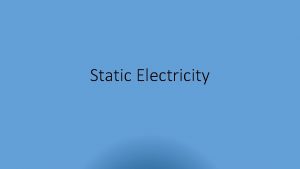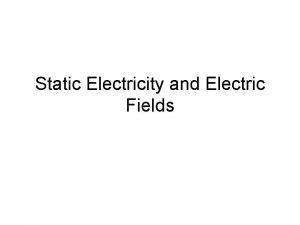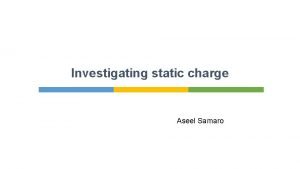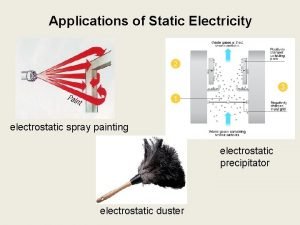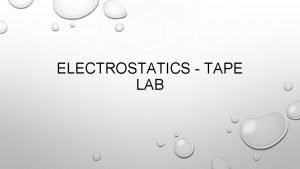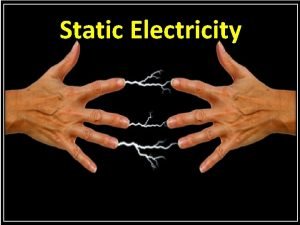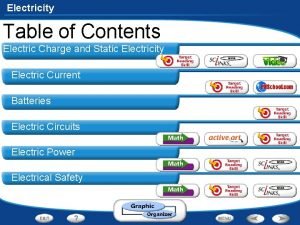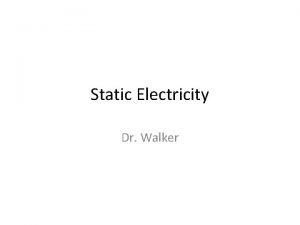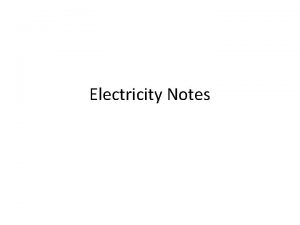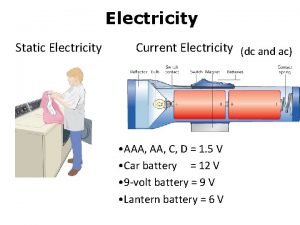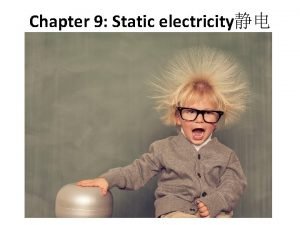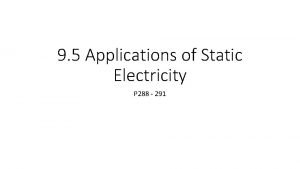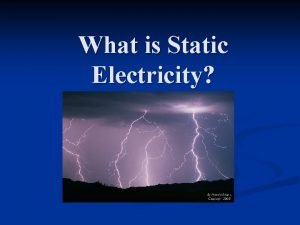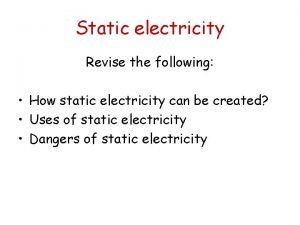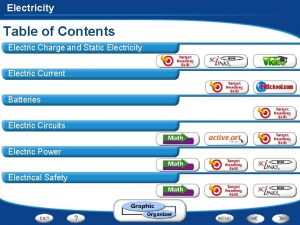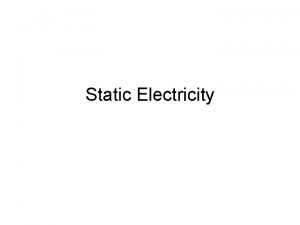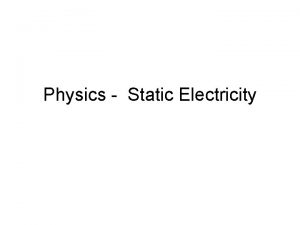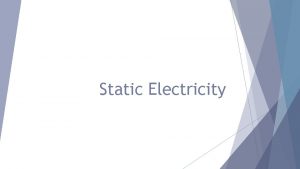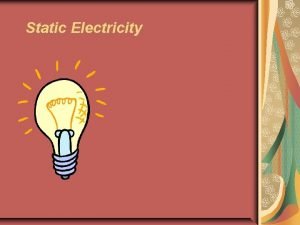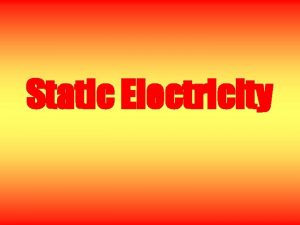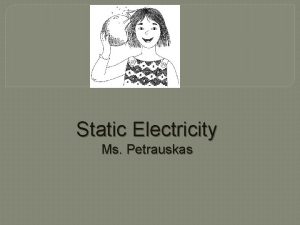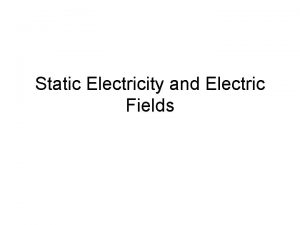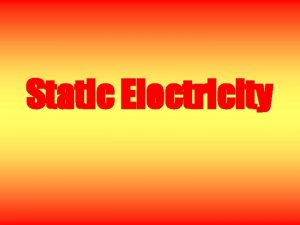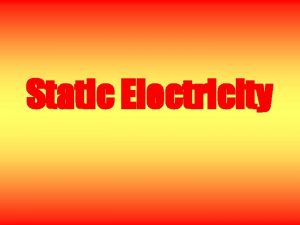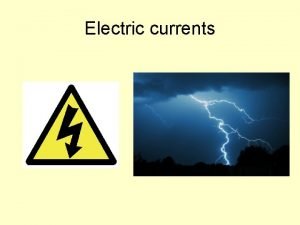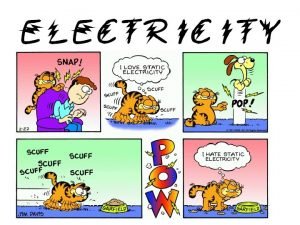Static Electricity 1 What is Static Electricity electrical






















- Slides: 22

Static Electricity

1. What is Static Electricity? • electrical charge that is built up on a surface

2. There are two kinds of charges • After being rubbed, a plastic ruler can attract paper scraps. Ruler carries electric charge. It exerts electric force on paper. Electric force the force of attraction or repulsion between electrically charged objects

3. Where do charges come from? Matter is made up of atoms with charged particles. + – neutron (neutral) + + – Proton (positive charge) + – atom – electron (negative charge) nucleus

3. Where do charges come from? If electrons = protons neutral If electrons > protons gaining electrons, negative charge If electrons < protons losing electrons, positive charge

3. Where do charges come from? • Electric field effect an electric charge has on other charges You’ll read more about this later…

4. Where do charges come from? Rubbing materials does NOT create electric charges. It just transfers electrons from one material to the other.

4. Where do charges come from? When a balloon rubs a piece of wool. . . – – – wool + + + electrons are pulled from the wool to the balloon. The balloon has more electrons than usual. The balloon: – charged, The wool: +charged 6. 24 x 1018 electrons = 1 C Lightning = 10 -20 C

5. Insulators and conductors Insulators: materials that do NOT allow electrons to flow through them easily. Insulators can be easily charged by friction as the extra electrons gained CANNOT easily escape.

4 Insulators and conductors Conductors: materials that allow electrons to flow through them easily. Conductors CANNOT be easily charged by friction as the extra electrons gained can easily escape.

6. Induction: The production of a charge in an uncharged body by bringing a charged object close to it When negatively charged rod is put near a metal can. . . - - - induced charges attraction top of the can: positive buttom of the can: negative ++ + + metal can electrons of the can are pushed away from the rod. - - + - repulsion & attraction > repulsion

6. Induction: The production of a charge in an uncharged body by bringing a charged object close to it • Or… • By contact or friction

Attraction of uncharged objects Similarly, when charged rod is close to paper scrap. . . - - - - attraction between the attraction rod and + charge > repulsion between the rod and - charge. ––– – ++ + + paper molecules of paper align. repulsion


7. Static Discharge stored charge in a surface is transferred quickly to another body Law of Conservation of Charge total charge of a system is constant – charges can only be transferred

A balloon has a negative charge when rubbed by a woollen cloth. 1 If the balloon can attract some paper scraps, which of the following cannot be the charge of paper scraps? A Neutral C Negative B Positive

A balloon has a negative charge when rubbed by woollen cloth. 2 During rubbing, what have been transferred between the woollen cloth and the balloon? A Electrons C Neutrons B Protons

8. How does a positively charged rod attract a neutral object? When a + charged rod is put near neutral object, negative charge is induced on the side of the object _______ positive charge is induced on the side near the rod and _______ away from the rod. The rod can attract the netural object attraction between rod and – induced charge > because _____ the ____ repulsion between rod and + induced charge. of Charges like charges repel, opposites attract a) Law



by By contact, and transfers electrons Contact not required, no transfer, realignment of charge/electrons in material Eg. The paper scraps; a negative object near a neutral object, electrons push away, positive end attracted to negative object Charge transfer Induced charges attraction repulsion

• Work your Quarter 2 lab groups • Complete exit ticket (leave in your packet) before you leave!!!
 Static electricity and current electricity
Static electricity and current electricity Current electricity
Current electricity How are static electricity and current electricity alike
How are static electricity and current electricity alike Static electricity examples
Static electricity examples What is electricity made of
What is electricity made of Static electricity review
Static electricity review Does magnetic field exerts force on a static charge
Does magnetic field exerts force on a static charge Venn diagram series and parallel circuits
Venn diagram series and parallel circuits Static electricity
Static electricity Static electricity tape lab
Static electricity tape lab Static electricity
Static electricity Static electricity table
Static electricity table Triboelectric series
Triboelectric series Conduction vs induction
Conduction vs induction Ampere unit
Ampere unit Static electricity
Static electricity Static electricity painting
Static electricity painting Static electricity
Static electricity Photocopier static electricity
Photocopier static electricity Static electricity
Static electricity Electric charges
Electric charges Difference between static and current electricity
Difference between static and current electricity Static electricity
Static electricity



